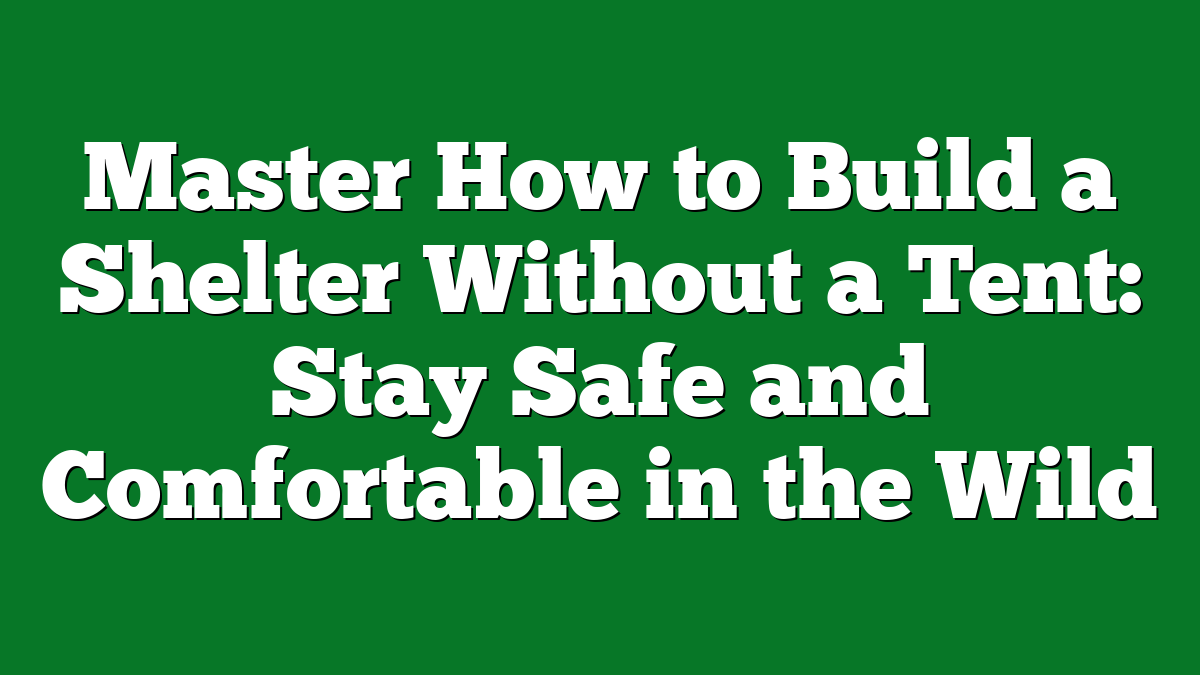When you’re out in the wild and find yourself without a tent, building a shelter might feel daunting. But don’t worry, I’ve been there, and it’s easier than you might think! Creating a makeshift shelter can be a fun and rewarding challenge that not only keeps you safe but also connects you with nature.
Understanding the Need for a Shelter
A reliable shelter protects against the elements and provides a secure area for rest. In the wild, weather conditions can change rapidly. Rain, wind, or cold temperatures can create discomfort and even pose health risks.
A well-built shelter offers protection from these threats. It keeps me dry and warm, especially during unexpected downpours or chilly nights. Additionally, it offers a safe space away from insects or wildlife, enhancing my overall comfort and safety.
Shelter serves as a central point for my camping experience. It acts as a gathering spot for cooking meals, sharing stories, or simply enjoying the beauty of nature. Knowing how to create a shelter contributes to my self-sufficiency, enhancing my confidence in the wild.
Understanding the importance of shelter is the first step in the camping journey. It combines knowledge, resourcefulness, and creativity, transforming a camping trip into a successful outdoor adventure.
Choosing the Right Location
Choosing the right location for a makeshift shelter is essential for staying safe and comfortable in the wild. By assessing the environment and avoiding hazards, I can ensure a successful camping experience.
Assessing the Environment
Assessing the environment starts with looking for flat ground. I prioritize areas that offer ample space and protection from wind or rain. Checking the surroundings for natural resources like nearby water sources can also be beneficial for cooking and drinking. It’s helpful to observe the position of the sun throughout the day. Situating my shelter in a spot that receives morning sunlight helps warm up the area. Additionally, considering my proximity to food sources, such as berry bushes or fishing spots, can enhance my overall experience.
Avoiding Hazards
Avoiding hazards plays a vital role in my decision-making process. I steer clear of low-lying areas that could collect rainwater and create puddles. Avoiding places directly beneath dead trees or overhanging branches prevents unexpected dangers from falling debris. It’s wise to stay a safe distance from potential wildlife habitats, such as dens or nests, to minimize encounters with animals. Lastly, I always check for signs of flooding, insect activity, and unstable ground to ensure my chosen location remains safe throughout my stay.
Materials for Building a Shelter
Gathering the right materials is crucial for constructing a sturdy and effective shelter in the wild. I’ve found that both natural and man-made resources can offer strong options.
Natural Materials
- Branches: Use sturdy, thick branches for the framework. You’ll find fallen branches on the forest floor that are perfect for supporting the structure.
- Leaves: Collect large leaves for roofing. They add additional insulation and help deflect rain, keeping your shelter dry.
- Bark: Strip bark from trees to create walls or floors. It’s durable and provides insulation against the cold ground.
- Grass and Moss: Gather thick grass or moss for bedding. These materials help keep you comfortable and warm while sleeping.
- Rocks: Utilize rocks as foundation blocks. They provide stability and prevent your shelter from collapsing in windy conditions.
Man-Made Materials
- Tarps: Carry a lightweight tarp to serve as an excellent weather-resistant covering. It can be easily configured into a roof or walls.
- Rope: A sturdy rope is invaluable for tying materials together. Paracord works well due to its strength and versatility.
- Nails and Stakes: Pack some nails or stakes. These can help secure your shelter in place, especially on sloped terrain.
- Foam Sheets: If you can pack them, foam sheets provide extra insulation and cushioning, making your shelter cozier.
- Survival Gear: Items like emergency blankets can serve multiple purposes, from warmth to reflectivity for signaling.
Combining these natural and man-made materials enhances your shelter’s effectiveness, ensuring comfort and safety in the wild.
Different Types of Makeshift Shelters
Creating a shelter in the wild opens up a world of possibilities. Here are three effective makeshift shelters I’ve used and recommend for outdoor adventures.
Lean-To Shelter
A lean-to shelter provides quick protection. I usually find a solid tree or rock as the back support. Then, I gather long branches and place them against the support, forming a slanted roof. To make it cozy, I thatch it with leaves or smaller branches. This design offers great wind and rain protection, and its simplicity makes it perfect for short trips or emergencies.
A-Frame Shelter
An A-frame shelter is another reliable option for camping. I start by finding two sturdy trees and placing a long pole between them as the peak. From this pole, I lean smaller branches down on both sides, creating an A-shape. Once I cover it with foliage, I ensure it’s insulated. This structure offers stability and can be larger than a lean-to, making it suitable for multiple campers or longer stays.
Debris Hut
A debris hut excels in insulation and camouflage. I begin by building a strong frame with sticks, forming a low structure about three feet high. Next, I pile a generous layer of leaves, moss, and debris over the frame. This technique traps heat effectively, keeping me warm at night. I place an entrance on the leeward side for wind protection. The effort rewards me with a snug haven that blends perfectly into the surroundings, providing safety from the elements.
Embracing these makeshift shelters not only fosters creativity but also connects me deeply with nature on my camping excursions. Each shelter serves as a valuable tool for any outdoor enthusiast looking to enhance their wilderness experience.
Tips for Enhancing Your Shelter
Creating a shelter goes beyond just building a structure; it involves making your space comfortable and secure against the elements. I’ve picked up a few techniques along my camping adventures that can really elevate your makeshift shelter.
Insulation Techniques
Insulation plays a crucial role in keeping your shelter warm. I always look for natural materials like leaves, pine needles, or moss, as they can be stacked to create effective thermal barriers. Layering these materials on the ground also helps cushion your sleep surface and keeps you insulated from the cold earth. Additionally, using logs or large rocks can retain warmth inside, especially if you build a small fire nearby. It’s essential to ensure the insulation covers every inch of your shelter; gaps can lead to heat loss. Incorporating extra layers as the temperature drops ensures a cozy refuge for a good night’s rest.
Weatherproofing Methods
Weatherproofing is key in protecting your shelter from rain and wind. I often utilize materials such as large leaves or branches to create a roof overhang. This method directs water away from the entrance and keeps the interior dry. Tarps or plastic sheets are excellent additions; they can be tied overhead to form a protective barrier against rain. Additionally, packing soil or rocks around the base of your shelter helps prevent wind from finding its way inside. Sealing all edges is vital, as small openings can create drafts. The combination of these weatherproofing techniques will make your makeshift shelter a reliable haven in any storm.
Conclusion
Building a shelter without a tent can be an exciting challenge that deepens your connection with nature. It’s all about embracing your creativity and resourcefulness. Each time I’ve crafted a makeshift shelter, I’ve learned something new about the environment and my own capabilities.
Finding the right materials and location makes all the difference in creating a safe and comfortable space. Whether you choose a lean-to or a debris hut, each design offers its own unique advantages.
So next time you head into the wild, remember that a little ingenuity can go a long way. You might just find that building your own shelter is one of the most rewarding parts of your outdoor adventure.











